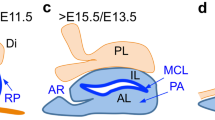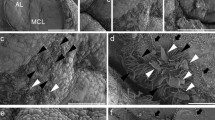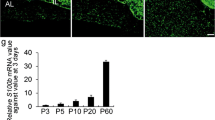Abstract
S100β-positive cells exist in the marginal cell layer (MCL) of the adenohypophysis and follicle structure in the parenchyma of anterior lobe (ALFS) in pituitary. They have multiple functions as phagocytes or cells that regulate hormone secretion. Majority of S100β-positive cells in the adenohypophysis express sex determining region Y-box 2 protein (SOX2), a stem cell marker; therefore, S100β/SOX2 double positive cells are also considered as one type of stem/progenitor cells. MCL and ALFS are consisting of morphologically two types of cells, i.e., multiciliated cells and non-ciliated cells. However, the relationship between the S100β-positive cells and multiciliated cells in the pituitary is largely unknown. In the present study, we first immunohistochemically verified the feature of multiciliated cells in MCL and ALFS. We then examined the expression patterns of FOXJ1, an essential expression factor for multiciliated cell-differentiation, and SOX2 in the S100β-positive multiciliated cells by in situ hybridization and immunohistochemistry. We identified anew the S100β/SOX2/FOXJ1 triple positive multiciliated cells, and revealed that they were dispersed throughout the MCL and ALFS. These results indicate that the MCL and ALFS are consisting of morphologically and functionally distinct two types of cells, i.e., S100β/SOX2 double positive non-ciliated cells and S100β/SOX2/FOXJ1 triple positive multiciliated cells.





Similar content being viewed by others
References
Shirasawa N, Kihara H, Yamaguchi S, Yoshimura F (1983) Pituitary folliculo-stellate cells immunostained with S-100 protein antiserum in postnatal, castrated and thyroidectomized rats. Cell Tissue Res 231:235–249
Soji T, Sirasawa N, Kurono C, Yashiro T, Herbert DC (1994) Immunohistochemical study of the post-natal development of the folliculo-stellate cells in the rat anterior pituitary gland. Tissue Cell 26:1–8
Yoshida S, Kato T, Yako H, Susa T, Cai LY, Osuna M, Inoue K, Kato Y (2011) Significant quantitative and qualitative transition in pituitary stem/progenitor cells occurs during the postnatal development of the rat anterior pituitary. J Neuroendocrinol 23:933–943
Fauquier T, Rizzoti K, Dattani M, Lovell-Badge R, Robinson IC (2008) SOX2-expressing progenitor cells generate all of the major cell types in the adult mouse pituitary gland. Proc Natl Acad Sci USA 105:2907–2912
Allaerts W, Vankelecom H (2005) History and perspectives of pituitary folliculo-stellate cell research. Eur J Endocrinol 153:1–12
Höfler H, Denk H, Walter GF (1984) Immunohistochemical demonstration of cytokeratins in endocrine cells of the human pituitary gland and in pituitary adenomas. Virchows Arch A Pathol Anat Histopathol 404:359–368
Allaerts W, Fluitsma DM, Hoefsmit EC, Jeucken PH, Morreau H, Bosman FT, Drexhage HA (1996) Immunohistochemical, morphological and ultrastructural resemblance between dendritic cells and folliculo-stellate cells in normal human and rat anterior pituitaries. J Neuroendocrinol 8:17–29
Yoshida S, Kato T, Kato Y (2016) Regulatory system for stem/progenitor cell niches in the adult rodent pituitary. Int J Mol Sci 17:75
Choksi SP, Lauter G, Swoboda P, Roy S (2014) Switching on cilia: transcriptional networks regulating ciliogenesis. Development 141:1427–1441
Bloodgood RA (2010) Sensory reception is an attribute of both primary cilia and motile cilia. J Cell Sci 123:505–509
Correr S, Motta PM (1981) The rat pituitary cleft: a correlated study by scanning and transmission electron microscopy. Cell Tissue Res 215:515–529
Yoshimura F, Soji T, Kiguchi Y (1977) Relationship between the follicular cells and marginal layer cells of the anterior pituitary. Endocrinol Jpn 24:301–305
Ciocca D (1980) Scanning electron microscopy of the cleft of the rat pituitary. Cell Tissue Res 206:139–143
Correr S, Motta PM (1985) A scanning electron-microscopic study of “supramarginal cells” in the pituitary cleft of the rat. Cell Tissue Res 241:275–281
Hannenhalli S, Kaestner KH (2009) The evolution of Fox genes and their role in development and disease. Nat Rev Genet 10:233–240
Lam EWF, Brosens JJ, Gomes AR, Koo C-Y (2013) Forkhead box proteins: tuning forks for transcriptional harmony. Nat Rev Cancer 13:482–495
Okada A, Ohta Y, Brody S, Watanabe H, Krust A, Chambon P, Iguchi T (2004) Role of foxj1 and estrogen receptor alpha in ciliated epithelial cell differentiation of the neonatal oviduct. J Mol Endocrinol 32:615–625
Lim L, Zhou H, Costa RH (1997) The winged helix transcription factor HFH-4 is expressed during choroid plexus epithelial development in the mouse embryo. Proc Natl Acad Sci USA 94:3094–3099
Pelletier GJ, Brody SL, Liapis H, White RA, Hackett BP (1998) A human forkhead/winged-helix transcription factor expressed in developing pulmonary and renal epithelium. Am J Physiol 274:L351–L359
Blatt EN, Yan XH, Wuerffel MK, Hamilos DL, Brody SL (1999) Forkhead transcription factor HFH-4 expression is temporally related to ciliogenesis. Am J Respir Cell Mol Biol 21:168–176
Tichelaar JW, Wert SE, Costa RH, Kimura S, Whitsett JA (1999) HNF-3/forkhead homologue-4 (HFH-4) is expressed in ciliated epithelial cells in the developing mouse lung. J Histochem Cytochem 47:823–831
Yu X, Ng CP, Habacher H, Roy S (2008) Foxj1 transcription factors are master regulators of the motile ciliogenic program. Nat Genet 40:1445–1453
Tichelaar JW, Lim L, Costa RH, Whitsett JA (1999) HNF-3/forkhead homologue-4 influences lung morphogenesis and respiratory epithelial cell differentiation in vivo. Dev Biol 213:405–417
Brody SL, Yan XH, Wuerffel MK, Song S-K, Shapiro SD (2000) Ciliogenesis and left–right axis defects in forkhead factor HFH-4—null mice. Am J Respir Cell Mol Biol 23:45–51
Chen J, Knowles HJ, Hebert JL, Hackett BP (1998) Mutation of the mouse hepatocyte nuclear factor/forkhead homologue 4 gene results in an absence of cilia and random left-right asymmetry. J Clin Invest 102:1077–1082
Stubbs JL, Oishi I, Izpisua Belmonte JC, Kintner C (2008) The forkhead protein Foxj1 specifies node-like cilia in Xenopus and zebrafish embryos. Nat Genet 40:1454–1460
Nakakura T, Suzuki T, Nemoto T, Tanaka H, Asano-Hoshino A, Arisawa K, Nishijima Y, Kiuchi Y, Hagiwara H (2016) Intracellular localization of α-tubulin acetyltransferase ATAT1 in rat ciliated cells. Med Mol Morphol 49:133–143
Nakakura T, Sato M, Suzuki M, Hatano O, Takemori H, Taniguchi Y, Minoshima Y, Tanaka S (2009) The spatial and temporal expression of delta-like protein 1 in the rat pituitary gland during development. Histochem Cell Biol 131:141–153
Fujiwara K, Maekawa F, Kikuchi M, Takigami S, Yada T, Yashiro T (2007) Expression of retinaldehyde dehydrogenase (RALDH)2 and RALDH3 but not RALDH1 in the developing anterior pituitary glands of rats. Cell Tissue Res 328:129–135
Nakakura T, Suzuki M, Watanabe Y, Tanaka S (2007) Possible involvement of brain-derived neurotrophic factor (BDNF) in the innervation of dopaminergic neurons from the rat periventricular nucleus to the pars intermedia. Zool Sci 24:1086–1093
Jacquet BV, Salinas-Mondragon R, Liang H, Therit B, Buie JD, Dykstra M, Campbell K, Ostrowski LE, Brody SL, Ghashghaei HT (2009) FoxJ1-dependent gene expression is required for differentiation of radial glia into ependymal cells and a subset of astrocytes in the postnatal brain. Development 136:4021–4031
Nakakura T, Soda A, Unno K, Suzuki M, Tanaka S (2010) Expression of IGFBP7 mRNA in corticotrophs in the anterior pituitary of adrenalectomized rats. J Histochem Cytochem 58:969–978
Horiguchi K, Higuchi M, Yoshida S, Nakakura T, Tateno K, Hasegawa R, Takigami S, Ohsako S, Kato T, Kato Y (2014) Proton receptor GPR68 expression in dendritic-cell-like S100β-positive cells of rat anterior pituitary gland: GPR68 induces interleukin-6 gene expression in extracellular acidification. Cell Tissue Res 358:515–525
Matsuzaki T, Inahata Y, Sawai N, Yang CY, Kobayashi M, Takata K, Ozawa H (2011) Immunohistochemical localization of the water channels AQP4 and AQP5 in the rat pituitary gland. Acta Histochem Cytochem 44:259–266
Didon L, Zwick RK, Chao IW, Walters MS, Wang R, Hackett NR, Crystal RG (2013) RFX3 modulation of FOXJ1 regulation of cilia genes in the human airway epithelium. Respir Res 14:70
Ferri ALM, Cavallaro M, Braida D, Di Cristofano A, Canta A, Vezzani A, Ottolenghi S, Pandolfi PP, Sala M, DeBiasi S, Nicolis SK (2004) Sox2 deficiency causes neurodegeneration and impaired neurogenesis in the adult mouse brain. Development 131:3805–3819
Tompkins DH, Besnard V, Lange AW, Wert SE, Keiser AR, Smith AN, Lang R, Whitsett JA (2009) Sox2 is required for maintenance and differentiation of bronchiolar clara, ciliated, and goblet cells. PLoS One 4:e8248
Tompkins DH, Besnard V, Lange AW, Keiser AR, Wert SE, Bruno MD, Whitsett JA (2011) Sox2 activates cell proliferation and differentiation in the respiratory epithelium. Am J Respir Cell Mol Biol 45:101–110
Acknowledgments
We are grateful to Ms. Yuri Amakawa at Teikyo University for useful technical support.
Author information
Authors and Affiliations
Corresponding author
Ethics declarations
Funding
This work was supported in part by a Grant-in-Aid for Young Scientists (B) (16K18982) to T. N. from the Ministry of Education, Culture, Sports, Science and Technology of Japan and by a research Grant from Teikyo University School of Medicine.
Conflict of interest
The authors declare no conflict of interest that might prejudice the impartiality of this research.
Rights and permissions
About this article
Cite this article
Nakakura, T., Suzuki, T., Horiguchi, K. et al. Expression and localization of forkhead box protein FOXJ1 in S100β-positive multiciliated cells of the rat pituitary. Med Mol Morphol 50, 59–67 (2017). https://doi.org/10.1007/s00795-016-0148-1
Received:
Accepted:
Published:
Issue Date:
DOI: https://doi.org/10.1007/s00795-016-0148-1




